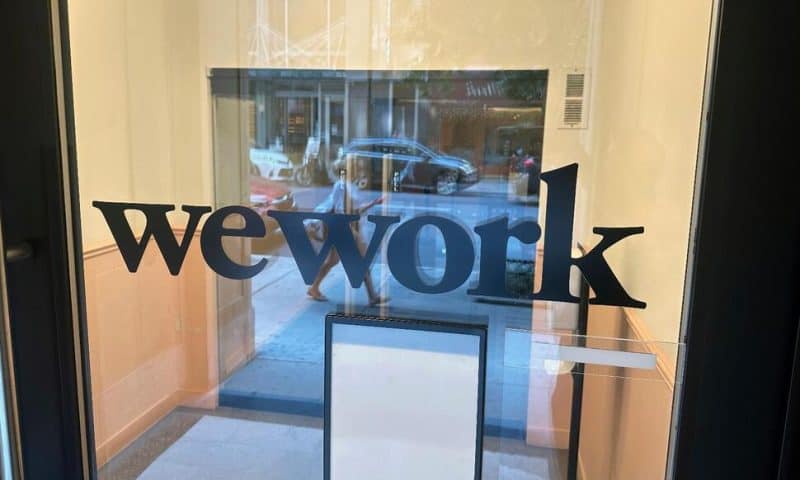WeWork says it will renegotiate nearly all of its leases, an announcement coming just weeks after the workspace-sharing provder sounded the alarm on its future ability to stay in business
NEW YORK — WeWork said Wednesday it will attempt to renegotiate nearly all of its leases and may exit some properties, an announcement coming just weeks after the workspace-sharing company sounded the alarm over its ability to remain in business.
The New York company must reduce its operating costs — notably its current lease liabilities, which “remain too high and are dramatically out of step with current market conditions,” WeWork Interim CEO David Tolley said in a statement published on the company’s website.
WeWork’s lease liabilities accounted for more than two-thirds of its operating expenses for the second quarter of this year, Tolley said. As of June 30, WeWork had 777 locations in 39 countries.
“We will seek to negotiate terms with our landlords that allow WeWork to maintain our unmatched quality of service and global network, in a financially sustainable manner,” Tolley wrote — adding that the company expects to exit “unfit and underperforming locations” as part of these negotiations.
Last month, speculation around WeWork’s future and a potential bankruptcy filing heightened after the company warned there was “substantial doubt” about its ability to continue as a going concern , meaning it might not have the resources needed to operate and stay in business. WeWork pointed to rising member churn and other financial losses, noting that its ability to stay in operation would be contingent upon improving its liquidity and profitability over the next 12 months.
“Among my clients that have WeWork as a tenant, there is obviously overall concern about its viability and a concern for them filing for Chapter 11 (bankruptcy protection),” said Jonathan Adelsberg, a senior partner and co-chair of the Real Estate Department at New York law firm Herrick, Feinstein LLP.
At the same time, the prospect of bankruptcy may put the company in a stronger negotiating position as landlords with WeWork leases try to protect themselves, said Sam Chandan, director of the Chao-Hon Chen Institute for Global Real Estate Finance at New York University’s Stern School of Business.
“WeWork’s challenges are not a secret to anyone,” Chandan said — adding that pressure on cash flow and income seen across the office market today can also limit landlords’ negotiation power. “The primary motivation for landlords today is to secure tenant retention, (so) I think we can expect to see the landlords come to the table.”
While bankruptcy isn’t guaranteed and might not lead to large-scale WeWork location closures, Adelsberg and others note that there’s been concern about WeWork’s viability in a number of buildings for years.
The shuttering of select WeWork locations isn’t new. Just last fall, the company announced plans to exit 40 underperforming U.S. locations. And over recent years, WeWork has stopped paying rent or exited lease agreements early for a handful of locations nationwide, according to credit rating and research firm Morningstar Credit. In some cases, landlords’ building loans moved to special servicing after losing WeWork as a tenant.
Exiting locations and the prospect of further negotiations is complicated because each of WeWork’s lease agreements is different, said David Putro, head of commerical real estate analytics at Morningstar Credit.
“It’s going to be building by building and landlord by landlord,” Putro said, pointing to variables like the existing terms of each lease, landlords’ financial needs and loan prospects and whether or not additional servicer approval is required for renegotiations. The process to renegotiate so many leases could take months, if not longer, he said.
WeWork’s plans to renegotiate most of its leases also arrive at a time when demand for office space is weak overall. The COVID-19 pandemic led to rising vacancies in commercial real estate — with many Americans still spending at least part of the week working from home. Major U.S. markets struggling to improve office space occupancy include San Francisco, New York, Chicago and Washington, D.C.
Putro expects that cities with a larger number of WeWork locations, like New York and San Francisco, could be impacted by the company’s upcoming expected closures as part of consolidation efforts. There may also be smaller markets that WeWork exits out of entirely, Chandan added — pointing to some of the wording in Wednesday’s announcement about the company intending to stay in the “majority” of its markets.
WeWork went public in October 2021 after its first attempt to do so two years earlier collapsed spectacularly, leading to the ousting of its CEO and founder, Adam Neumann. The company was valued at $47 billion at one point, before investors started to drop off due to Neumann’s erratic behavior and exorbitant spending. It’s still dealing with the fallout of its initial aggressive expansion.
But Tolley still sounded an optimistic note Wednesday — stating that “WeWork is here to stay” and grow in “to meet evolving workplace needs far into the future.”
Shares of WeWork were down about 3% in afternoon trading Wednesday.

